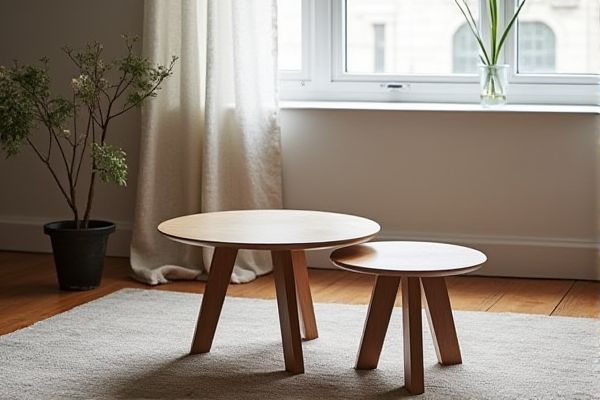
Nesting tables save space by fitting smaller tables under larger ones, making them ideal for compact areas, while stacking tables prioritize vertical storage, allowing multiple tables to be piled when not in use. Discover which option best suits Your space and functional needs by reading the rest of the article.
Table of Comparison
| Feature | Nesting Tables | Stacking Tables |
|---|---|---|
| Definition | Embedding one table inside a cell of another table. | Placing multiple tables vertically, one after another. |
| Use Case | Complex data grouping within a single table structure. | Separate related data sets displayed sequentially. |
| Complexity | Higher, due to multi-level structure and alignment. | Lower, simpler and easier to maintain. |
| Readability | Can reduce clarity if deeply nested. | Improves clarity by separating data logically. |
| Responsiveness | Less flexible, harder to make responsive. | More adaptable to responsive design. |
| Performance | Potentially slower rendering due to complexity. | Generally faster and lighter to render. |
| Accessibility | Requires careful markup to ensure screen reader compatibility. | Easier to make accessible with standard tagging. |
| Styling | More challenging to style uniformly. | Simpler to customize styles for individual tables. |
Introduction to Nesting Tables and Stacking Tables
Nesting tables are designed to fit perfectly within one another, optimizing space and offering versatile usage for living areas and offices. Stacking tables are crafted to be placed one on top of the other, allowing easy storage and quick setup for events or compact spaces. Both table types enhance functionality and organization by addressing space-saving needs in distinct ways.
Design Differences: Nesting vs. Stacking Tables
Nesting tables feature tapered legs and varying sizes that allow smaller tables to slide neatly under larger ones, optimizing floor space and enhancing versatility in room layouts. Stacking tables, designed with uniform dimensions and sturdy construction, are built to be vertically piled, facilitating easy storage and transport for multipurpose environments. Design differences between nesting and stacking tables center around space efficiency and functional adaptability, with nesting tables emphasizing compact integration and stacking tables prioritizing modular portability.
Space-Saving Capabilities Compared
Nesting tables provide superior space-saving capabilities by fitting smaller tables neatly under larger ones, maximizing vertical space usage in compact areas. Stacking tables, while also space-efficient, require more vertical clearance and storage space when piled, limiting their utility in low-ceiling environments. For optimal space management in small rooms or offices, nesting tables offer a more versatile and streamlined solution.
Material and Style Considerations
Nesting tables are typically crafted from lightweight materials such as solid wood, metal alloys, or high-grade plastic, allowing easy movement and space-saving functionality, with styles ranging from modern minimalist to mid-century classic. Stacking tables often utilize durable materials like steel or composite wood designed to withstand weight and frequent handling, making them suitable for industrial, commercial, or casual settings where practicality is prioritized over intricate design. Selecting between nesting and stacking tables depends on balancing the desired aesthetic appeal and the material's structural properties to suit specific interior design themes and usage demands.
Versatility and Usage Scenarios
Nesting tables maximize space efficiency by fitting smaller tables under larger ones, ideal for compact living areas and flexible arrangements in multifunctional rooms. Stacking tables offer quick, vertical storage solutions, perfect for event spaces and environments requiring frequent setup and teardown. Both designs enhance versatility, with nesting tables suited for dynamic layouts and stacking tables optimized for portability and ease of storage.
Ease of Storage and Mobility
Nesting tables offer enhanced ease of storage by fitting one table neatly under another, significantly reducing the space required compared to stacking tables, which are piled vertically and may become unstable. Mobility is more convenient with nesting tables as individual units can be moved separately without disturbing the entire set, whereas stacked tables often require moving all tables at once or unstacking to access. Your choice between the two should consider how often you need to rearrange or store the tables in compact spaces.
Durability and Maintenance Requirements
Nesting tables offer enhanced durability due to their compact design, which reduces wear and tear by minimizing exposure when stored. Stacking tables, while sturdy, often endure more frequent handling and surface contact, potentially increasing maintenance needs over time. Your choice should consider how often you move and store the tables, as nesting tables generally require less upkeep and maintain their finish better.
Cost and Value for Money
Nesting tables typically offer better cost-efficiency by combining multiple surfaces into a compact design, maximizing space utility while minimizing the need for additional furniture. Stacking tables may require more units to achieve the same surface area, potentially increasing overall expenses but providing greater flexibility in seating arrangements. Evaluating cost against value for money depends on space constraints and usage frequency, with nesting tables excelling in small areas and stacking tables favored in versatile, high-capacity environments.
Best Use Cases: Home and Office Applications
Nesting tables offer space-saving solutions ideal for small home living rooms or compact office areas, allowing you to store multiple tables neatly when not in use. Stacking tables provide flexibility for environments requiring quick setup and rearrangement, such as conference rooms or multi-purpose home study spaces. Your choice depends on balancing convenience and the frequency of reconfiguration needed in your home or office setting.
Conclusion: Which Table Type Should You Choose?
Nesting tables offer space-saving benefits and a sleek, compact design ideal for small areas, while stacking tables provide flexibility for larger gatherings and easier storage. Your choice depends on your available space, frequency of use, and need for mobility or versatility. For tight spaces requiring minimal clutter, nesting tables are optimal, whereas stacking tables suit multi-purpose environments demanding quick setup and breakdown.
 homyna.com
homyna.com